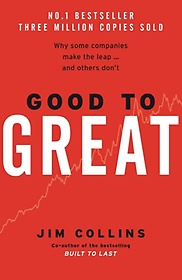 |
 |
|||||
|
||||||

|

- 제휴몰 주문 시 고객보상, 일부 이벤트 참여 및 증정품 증정, 하루/당일 배송에서 제외되므로 참고 바랍니다.
-

-

-
The Challenge
"Built to Last, " the defining management study of the nineties, showed how great companies triumph over time and how long-term sustained performance can be engineered into the DNA of an enterprise from the verybeginning.But what about the company that is not born with great DNA? How can good companies, mediocre companies, even bad companies achieve enduring greatness?
The Study
For years, this question preyed on the mind of Jim Collins. Are there companies that defy gravity and convert long-term mediocrity or worse into long-term superiority? And if so, what are the universal distinguishing characteristics that cause a company to go from good to great?The Standards
Using tough benchmarks, Collins and his research team identified a set of elite companies that made the leap to great results and sustained those results for at least fifteen years. How great? After the leap, the good-to-great companies generated cumulative stock returns that beat the general stock market by an average of seven times in fifteen years, better than twice the results delivered by a composite index of the world''s greatest companies, including Coca-Cola, Intel, General Electric, and Merck.The Comparisons
The research team contrasted the good-to-great companies with a carefully selected set of comparison companies that failed to make the leap from good to great. What was different? Why did one set of companies become truly great performers while the other set remained only good?Over five years, the team analyzed the histories of all twenty-eight companies in the study. After sifting through mountains of data and thousands of pages of interviews, Collins and his crew discovered the key determinants of greatness -- why some companies make the leap and others don''t.
The Findings
The findings of the Good to Great study will surprise many readers and shed light on virtually every area of management strategy and practice. The findings include: Level 5 Leaders: The research team was shocked to discover the type of leadership required to achieve greatness. The Hedgehog Concept (Simplicity within the Three Circles): To go from good to great requires transcending the curse of competence. A Culture of Discipline: When you combine a culture of discipline with an ethic of entrepreneurship, you get the magical alchemy of great results. Technology Accelerators: Good-to-great companies think differently about the role of technology. The Flywheel and the Doom Loop: Those who launch radical change programs and wrenching restructurings will almost certainly fail to make the leap."Some of the key concepts discerned in the study," comments Jim Collins, "fly in the face of our modern business culture and will, quite frankly, upset some people."
Perhaps, but who can afford to ignore these findings?
-

- Acknowledgmentsp. ix Prefacep. xiii Good Is the Enemy of Greatp. 1 Level 5 Leadershipp. 17 First Who ... Then Whatp. 41 Confront the Brutal Facts (Yet Never Lose Faith)p. 65 The Hedgehog Concept (Simplicity within the Three Circles)p. 90 A Culture of Disciplinep. 120 Technology Acceleratorsp. 144 The Flywheel and the Doom Loopp. 164 From Good to Great to Built to Lastp. 188 Epilogue: Frequently Asked Questionsp. 211 Research Appendicesp. 219 Notesp. 261 Indexp. 287 Table of Contents provided by Syndetics. All Rights Reserved.
-

- 2004년 삼성경제연구소 CEO 추천도서 SERI 추천도서 모두 보러가기!! ▶ Go!
-

-

짐 콜린스(Jim Collins) [저] 
-
세계에서 가장 영향력 있는 경제학자이자 비즈니스 및 사회 분야 리더들의 경영 구루. 스탠퍼드대학교 경영학 과정을 마친 뒤 기업에서 근무하다 모교에서 ‘기업가 정신’을 강의하기 시작했고, 그 능력을 인정받아 ‘명강의 상’을 수상했다. 25년 이상 위대한 기업을 열성적으로 연구해오며 시대를 초월해 번영하는 위대한 기업의 성공 요인을 분석한 《성공하는 기업들의 8가지 습관》(공저), 경영의 바이블이라 불리는 《좋은 기업을 넘어 위대한 기업으로》를 출간해 큰 반향을 일으켰다. 연이어 《위대한 기업은 다 어디로 갔을까》 《위대한 기업의 선택》 《비영리 분야를 위한 좋은 조직을 넘어 위대한 조직으로》 《플라이휠을 돌려라》 등을 발표했다. 그의 책들은 전 세계에서 총 1,000만 부 이상 판매되었다.
콜로라도주 볼더에 설립한 ‘매니지먼트랩’(Management Lab)에서 실천적 경영원리를 개발하는 한편 CEO 및 고위 리더십 팀과 교류하며 연구, 강의, 컨설팅을 진행 중이다. 비즈니스 외에도 교육, 의료, 사회적 벤처 및 비영리 단체 등 다양한 사회 부문에서 학습과 교육에 열정을 쏟고 있다. 2017년 포브스는 짐 콜린스를 ‘현존하는 가장 위대한 100대 경영인’(100 Greatest Living Business Minds)으로 선정했다. -

 |
|||||||||||||||||||||||
|





 전체 0개의 구매후기가 있습니다.
전체 0개의 구매후기가 있습니다.








